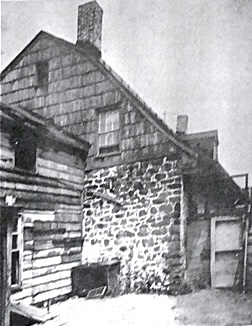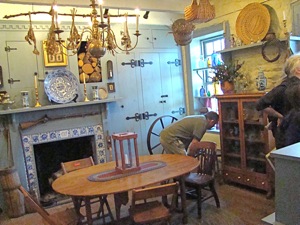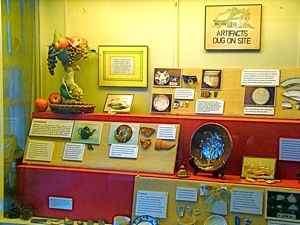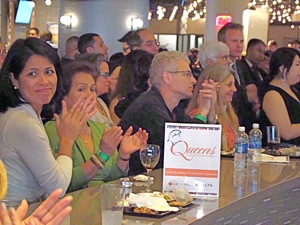Onderdonk House in Ridgewood Queens
Ridgewood Historical Society Home Endures The Centuries
 May 18, 2012 / Ridgewood Queens / Queens NY History / Queens Buzz. Ridgewood is home to the oldest Dutch-American field stone farmhouse in New York City. The farmhouse was built around 1709 by Paulus Vander Ende using field stone and timber. The house was sold to the Onderdonk family around 1800 and they lived in it for about a century. After that the house traded hands several times before a fire incident in 1975.
May 18, 2012 / Ridgewood Queens / Queens NY History / Queens Buzz. Ridgewood is home to the oldest Dutch-American field stone farmhouse in New York City. The farmhouse was built around 1709 by Paulus Vander Ende using field stone and timber. The house was sold to the Onderdonk family around 1800 and they lived in it for about a century. After that the house traded hands several times before a fire incident in 1975.
Following the fire incident, the Ridgewood Historical Society was formed and took the house over, and opened it to the public in 1982. Many of the objects shown in the house were found on site through archeological excavation. The house is currently home to the Ridgewood NY Historical Society.
Click here to read our report on the Onderdonk House in Ridgewood Queens NY, including photos. We have also included in this report information about the Gottschees and Gottscheer Hall, and one of the artist studios of the Queens Museum of Art art crawl in Ridgewood.
Vander Ende Onderdonk House - Ridgewood
Dutch American Colonial Past Preserved In Queens
May 18, 2012 / Ridgewood NY / Queens NY History / Queens Buzz. I headed down to  Ridgewood last Saturday to check out the Vander-Ende Onderdonk House, which is also home to the Ridgewood Historical Society of New York. The Queens Museum of Art was hosting an art crawl through the Ridgewood neighborhood, starting at the Onderdonk House and ending at Gotscheer Hall. Both of these locales are historic structures preserving a bit of our ‘ancient’ past.
Ridgewood last Saturday to check out the Vander-Ende Onderdonk House, which is also home to the Ridgewood Historical Society of New York. The Queens Museum of Art was hosting an art crawl through the Ridgewood neighborhood, starting at the Onderdonk House and ending at Gotscheer Hall. Both of these locales are historic structures preserving a bit of our ‘ancient’ past.
It was a beautiful sunny day with temperatures in the 70’s and nearly perfect for an art crawl, only some of which I attended. The main thrust of this story is about the Onderdonk House in Ridgewood, with a bit of the art crawl included throughout the report. In the photo at the table is Larissa Harris of the Queens Museum of Art and Virginia Comber of the Ridgewood Historical Society.
Vander Ende Onderdonk House - Ridgewood NY / Queens
 The Vander Ende - Onderdonk House is named after its two first owners: the Vander-Endes and the Onderdonks, both Dutch / American families. The site of the house is along the Ridgewood, Queens and Bushwich, Brooklyn border. About 300 years ago, this area was a woody, marshy land of rich soil located near an inlet body of water that is now called Newtown Creek. The print shown to your right gives one a sense of what Ridgewood Queens looked and felt like centuries ago.
The Vander Ende - Onderdonk House is named after its two first owners: the Vander-Endes and the Onderdonks, both Dutch / American families. The site of the house is along the Ridgewood, Queens and Bushwich, Brooklyn border. About 300 years ago, this area was a woody, marshy land of rich soil located near an inlet body of water that is now called Newtown Creek. The print shown to your right gives one a sense of what Ridgewood Queens looked and felt like centuries ago.
Dutch & English Settlers in Colonial New York
 The Dutch arrived in New York before the English and were the first to settle here. Through a combination of trading and fighting they settled these lands, which were once the roaming grounds of the Manhattan and Algonquin Indians.
The Dutch arrived in New York before the English and were the first to settle here. Through a combination of trading and fighting they settled these lands, which were once the roaming grounds of the Manhattan and Algonquin Indians.
The site of the Onderdonk House was first settled in the mid 1600’s by a farmer / goldsmith named Barentsz Hendrik who built a wooden house that was eventually demolished. At the time the New Amsterdam colony (which encompassed current day New York City and more) was governed by the Dutch.
The Dutch colony changed hands in 1664, and thereafter remained English (with one short hiatus 1673 – 74), until it became a part of the United States following the American Revolutionary War in 1783. The print above shows New York City [formerly New Amsterdam] in the late 1600's - the rounded area along the upper left leads into the harbor.
Vander Ende House - Dutch Colonial History in New York
In 1709, Paulus Vander Ende, also a Dutch settler, built the house that now stands near  the corner of Flushing Avenue and Onderdonk Avenue. He used field stones and timber to build the house. The timber was used for the columns, roof, floor, windows and doors. The Dutch doors are partitioned so that the upper half can be opened to let in fresh air and sunlight, while keeping animals out, while keeping in the children. The house also has Dutch windows, which are small with shutters.
the corner of Flushing Avenue and Onderdonk Avenue. He used field stones and timber to build the house. The timber was used for the columns, roof, floor, windows and doors. The Dutch doors are partitioned so that the upper half can be opened to let in fresh air and sunlight, while keeping animals out, while keeping in the children. The house also has Dutch windows, which are small with shutters.
The roof is gabled, with one side being shorter and steeper; while the other side is longer and slopes down more gradually. There are several fireplaces in the house, two of which are original to the house; and the other two are said to have been added later. An addition to the house was also added later on. In the photo to your left stands the unadorned Vander Ende Onderdonk House with the field stone walls, the gabled roof and small windows. The addition is shown in the foreground.
The Vander Endes had many children as well as servants and slaves. They all worked to cultivate the land, as farming was their line of work, some of which was sold using the Newtown Creek as passage.
Brooklyn & Queens - Dutch & English Colonial New York
 Generally the Dutch and English settlers lived in relative peace and harmony, but we have reports that the Dutch settlement of Boswijk in Breuckelen [Bushwick in Brooklyn] and the English settlement in Newtown in Queens used to occasionally have conflicts over access and use of the waterway that is now called Newtown Creek [see depiction in print above].
Generally the Dutch and English settlers lived in relative peace and harmony, but we have reports that the Dutch settlement of Boswijk in Breuckelen [Bushwick in Brooklyn] and the English settlement in Newtown in Queens used to occasionally have conflicts over access and use of the waterway that is now called Newtown Creek [see depiction in print above].
The Queens Museum of Art had brought along an historian who gave us a short description of those times, when waterways were the superhighways through which all things traveled, as well as being the major power source, providing energy for milling grains – not to mention drinking. These uses of water were not always compatible and the Dutch / English neighbors were at odds at times. The print above depicts an idyllic life lead by the colonial settlers of the 1700's in Queens NY.
Arbitration Rock - Bushwick Brooklyn & Newtown Queens Boundary
 We were reminded that centuries ago, surveying wasn’t the exacting measurement process it is today, and that frequently natural markers were used to square off parcels of land. In 1769 a border dispute between Kings [Brooklyn] and Queens County was settled by using a large rock, which was referred to as Arbitration Rock, to settle the land dispute. Arbitration Rock marked the boundary between English Newtown in Queens and Dutch Bushwick in Brooklyn. The rock had been moved and subsequently buried while building roads in the 1930’s and it was excavated in 2001 and moved to its current location behind the Onderdonk House.
We were reminded that centuries ago, surveying wasn’t the exacting measurement process it is today, and that frequently natural markers were used to square off parcels of land. In 1769 a border dispute between Kings [Brooklyn] and Queens County was settled by using a large rock, which was referred to as Arbitration Rock, to settle the land dispute. Arbitration Rock marked the boundary between English Newtown in Queens and Dutch Bushwick in Brooklyn. The rock had been moved and subsequently buried while building roads in the 1930’s and it was excavated in 2001 and moved to its current location behind the Onderdonk House.
The American Revolutionary War against England began in 1776. The Vander Ende House was captured by the British during the American Revolutionary War. The war of independence ended in 1783 when the English Crown recognized the United States as an independent nation. The charter for the United States government was ratified in 1789.
The Onderdonk House in Ridgewood Queens
 The Onderdonks, who were also Dutch American settlers, assumed possession of the house around the turn of the 19th century [1800] and lived in the house for about one hundred years. Most of the artifacts collected through the archeological dig reflect their daily lives. The photo to your left shows one of the rooms inside the Vander Ende Onderdonk House, the oldest Dutch colonial field stone house in New York City.
The Onderdonks, who were also Dutch American settlers, assumed possession of the house around the turn of the 19th century [1800] and lived in the house for about one hundred years. Most of the artifacts collected through the archeological dig reflect their daily lives. The photo to your left shows one of the rooms inside the Vander Ende Onderdonk House, the oldest Dutch colonial field stone house in New York City.
I went inside the house to observe the artifacts assembled by the museum. There was an archeological dig done in the latter half of the 20th century which yielded many artifacts that represent the bulk of the museum collection in the Onderdonk House. You can see some of the artifacts found at the Vander Ende Onderdonk House in the photo below.
 An archeological dig was done in the area surrounding the Onderdonk House. Most of the items recovered were likely those used by the Onderdonk family during the 1800’s. The items include a variety of found objects made of ceramics, porcelain, earthenware, leather, wood and metal.
An archeological dig was done in the area surrounding the Onderdonk House. Most of the items recovered were likely those used by the Onderdonk family during the 1800’s. The items include a variety of found objects made of ceramics, porcelain, earthenware, leather, wood and metal.
Many of the objects found were made of glass and ceramics and were used to store and prepare food. Bottles used to store medicine, perfume and ink were also found, along with wine and beer bottles.
Ridgewood NY - Centuries of Immigration in Queens County NY
 While the Onderdonks lived in the house, subsequent waves of immigrants came to the area. The Dutch and English were followed by the Germans and Irish throughout the 1800’s, followed by Italians who arrived in the late 19th and early 20th centuries.
While the Onderdonks lived in the house, subsequent waves of immigrants came to the area. The Dutch and English were followed by the Germans and Irish throughout the 1800’s, followed by Italians who arrived in the late 19th and early 20th centuries.
Following the departure of the Onderdonks, the house was used for stables, as greenhouse, an office, and a storage facility for the Apollo spacecraft [go figure]. It was abandoned in the 1970’s and nearly caught fire / burned down.
In the early / mid 20th century the Poles and Slavs arrived and immigrants from the Latin Americas arrived in the mid / late 20th century. One of the exhibits at the Ridgewood Historical Society in the Onderdonk House in Queens is shown above left.
The Gottschees & Gottscheer Hall - German Slovenia in NYC
 The Gottschees are Germans whose lands became Czechoslovakia in the wake of WWII, and hence many Gottscheers decided to emigrate to America where they ended up in Ridgewood NY. We’ll discuss the Gottschees a bit more in this report when we arrive at Gottscheer Hall.
The Gottschees are Germans whose lands became Czechoslovakia in the wake of WWII, and hence many Gottscheers decided to emigrate to America where they ended up in Ridgewood NY. We’ll discuss the Gottschees a bit more in this report when we arrive at Gottscheer Hall.
Following the historian’s description of what the early colonial times in Ridgewood Queens were like, we set out on the Queens Museum of Art [hereafter referred to as QMA] art studio tour. I jumped ahead to view the work of one of the artist’s studios, before continuing my journey into the Ridgewood past. The historian at Arbitration Rock and Tom Finkelpearl of the Queens Museum of Art are shown facing us in the background [left to right] in the photo above.
Small Black Door - Art Studios in Ridgewood NYC
 I arrived at the Small Black Door Studio, which seems appropriately named. The subterranean studio was co-founded by Matthew Mahler and Jonathan Terranova [see photo to left with 'small black door' opened between them]. Inside I found a sound man quietly playing some tunes, which I’m sure could be amped up on a moment’s notice.
I arrived at the Small Black Door Studio, which seems appropriately named. The subterranean studio was co-founded by Matthew Mahler and Jonathan Terranova [see photo to left with 'small black door' opened between them]. Inside I found a sound man quietly playing some tunes, which I’m sure could be amped up on a moment’s notice.
The works of ten local artists was on display. The art pieces shown were all modern, abstract, using a variety of techniques and mediums. There were two video installations.
Gottscheer Hall in Ridgewood near Bushwick Brooklyn
 I headed onto Gottscheer Hall, which was first erected in 1924 and later added to between 1952 and 1962 [photo of front bar shown at right]. The story of the Gottschees in America dates back to the late 1800's when many Gottschees emigrated to America. The Gottschees land had traded hands numerous times over past thousand years and several times in the period surrounding the two world wars. Gottschee county was a German speaking county located in southern Slovena on the Croatian border [formerly in Yugoslavia]. Many of the Gottschees fled during the first and second world wars because their homes became engulfed in territorial disputes.
I headed onto Gottscheer Hall, which was first erected in 1924 and later added to between 1952 and 1962 [photo of front bar shown at right]. The story of the Gottschees in America dates back to the late 1800's when many Gottschees emigrated to America. The Gottschees land had traded hands numerous times over past thousand years and several times in the period surrounding the two world wars. Gottschee county was a German speaking county located in southern Slovena on the Croatian border [formerly in Yugoslavia]. Many of the Gottschees fled during the first and second world wars because their homes became engulfed in territorial disputes.
The Gottschees congregated in the area around Ridgewood NY (and Cleveland, OH), where they kept alive their culture, with Gottscheer Hall as one of the central meeting places. It’s worth noting that the 66th Annual Gottschee Picnic is to be held on June 3, 2012 at Plattduetsche Park, 1132 Hempstead Turnpike in Franklin, NY. Miss Gottschee 2012 will be crowned at this event. It's worth noting that the Gottschees dialect of the German language is one of the oldest of its kind, dating back to the Middle Ages.
Queens - America's Melting Pot & Home To Centuries Of Immigration
 What a day. I had traveled back into Dutch colonial times, visited a 21st century artists gallery, and finished in a post war cultural enclave, inside of America’s cultural mosaic melting pot.
What a day. I had traveled back into Dutch colonial times, visited a 21st century artists gallery, and finished in a post war cultural enclave, inside of America’s cultural mosaic melting pot.
Sources and thanks: The Vander Ende Onderdonk House, Ridgewood Historical Society, Gottscheer Hall, Gottschee New York, the Queens Museum of Art and the Small Black Door.
In the photo to your right are shown some of the 70 - 100 participants in the Ridgewood Art Crawl sponsored by the Queens Museum of Art, beginning at the Vander Ende Onderdonk House.
Flushing / Corona Related Info
Click here to go to the Queens NY History section of this site.
Click these links for promotions by advertisers in Queens.
Click this link to go to the Flushing Neighborhood.
Site Search Tips. 1) For best results, when typing in more than one word, use quotation marks - eg "Astoria Park". 2) Also try either singular or plural words when searching for a specific item such as "gym" or "gyms".
$element(bwcore,insert_search,N)$
Click this link to search for something in our Queens Business Directory.
Click the log in link below to create an ID and post an opinion.
Or send this story to a friend by filling in the appropriate box below.













